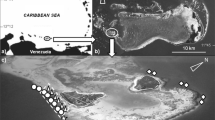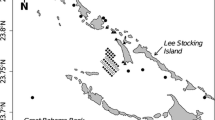Abstract
The invasion of lionfish (Pterois spp.) into the Gulf of Mexico has been well documented but to date few studies have presented analysis on abundance trends to evaluate population status and trends. We used trawl and reef fish video survey data to analyze abundance trends from 2010 to 2019. The trawl and camera survey data evaluated show a rapid increase of lionfish through 2016–2017 with subsequent stabilization or decreases in 2018 and 2019. Lionfish occupied multiple natural habitats across the northern Gulf of Mexico, have a strong affinity for hard bottom habitats with sponge, but no preference relative to low versus high relief reef types. Population growth trends indicated faster population growth in trawl surveys as compared to video indices. Incidental catch of sponge in trawls, which primarily occurred in the eastern Gulf of Mexico, was a significant variable explaining lionfish catch. Interestingly, there were few lionfish captured in the western Gulf of Mexico suggesting that the low-relief soft-bottom in that region is less suitable for lionfish. Artificial habitats in the western Gulf of Mexico could be providing necessary hard-bottom habitat for lionfish, however, survey data analyzed in this study cannot provide inference as these surveys are not conducted on those habitats. Careful consideration must be taken when implementing lionfish removal programs given a potential for increased population growth when harvest does not achieve overfishing. In addition monitoring of community level effects will be needed as predation and indirect competition for resources could potentially negatively impact native species.




Similar content being viewed by others
References
Aguilar-Perera A, Tuz-Sulub A (2010) Non-native, invasive red lionfish (Pterois volitans [Linnaeus, 1758]: Scorpaenidae), is first recorded in the southern Gulf of Mexico, off the northern Yucatan Peninsula, Mexico. Aquat Inv 5:9–12
Barbour AB, Montgomery ML, Adamson A, Díaz-Ferguson E, Silliman B (2010) Mangrove use by the invasive lionfish Pterois volitans. Mar Ecol Prog Ser 401:291–294. https://doi.org/10.3354/meps08373
Benkwitt CE, Albins MA, Buch KL, Ingeman KE, Kindinger TL, Pusack TJ, Stallings CD, Hixon MA (2017) Is the lionfish invasion waning? Evidence from the Bahamas. Coral Reefs 36:1255–1261
Betancur-R R, Hines A, Acero PA, Ortí G, Wilbur AE, Freshwater DW (2011) Reconstructing the lionfish invasion: insights into greater caribbean biogeography. J Biogeogr 38:1281–1293
Briggs JC (1958) A list of Florida fishes and their distribution. Bull Fla State Mus Biol Sci 2:221–318
Campbell MD, Rose KA, Boswell K, Cowan JH Jr (2011) Individual-based modeling of fish population dynamics of an artificial reef community: effects of habitat quantity and spatial arrangement. Ecol Model 222:3895–3909
Campbell MD, Pollack AG, Gledhill CT, Switzer TS, DeVries DA (2015) Comparison of indices of relative abundance generated from two methods of generating video count data. Fish Res 170:125–133
Chagaris D, Binion-Rock S, Bogdanoff A, Dahl K, Granneman J, Harris H, Mohan J, Rudd MB, Swenarton MK, Ahrens R, Patterson WF III, Morris JA Jr, Allen M (2017) An ecosystem based approach to evaluating impacts and management of invasive lionfish. Fisheries 42:421–431
Claydon JAB, Calosso MC, Traiger SB (2012) Progression of invasive lionfish in seagrass, mangrove and reef habitats. Mar Ecol Prog Ser 448:119–129
Dahl KA, Patterson WF III (2014) Habitat-specific density and diet of rapidly expanding invasive red lionfish, P. volitans, populations in the northern Gulf of Mexico. PLoS One 9(8):e105852
Dahl KA, Patterson WF III, Snyder RA (2016) Experimental assessment of lionfish removals to mitigate reef fish community shifts on northern Gulf of Mexico artificial reefs. Mar Ecol Prog Ser 558:207–221. https://doi.org/10.3354/meps11898
Dahl KA, Patterson WF III, Robertson A, Ortmann AC (2017) DNA barcoding significantly improves resolution of invasive lionfish diet in the Northern Gulf of Mexico. Biol Invasions 19(6):1917–1933
Dahl KA, Edwards MA, Patterson WF III (2019) Density-dependent condition and growth of invasive lionfish in the northern Gulf of Mexico. Mar Ecol Prog Ser 623:145–159
de León R, Vane K, Bertuol P, Chamberland VC, Simal F, Imms E, Vermeij MJ (2013) Effectiveness of lionfish removal efforts in the southern Caribbean. Endanger Species Res 22(2):175–182
Diller J, Frazer T, Jacoby C (2014) Coping with the lionfish invasion: evidence that naïve, native predators can learn to help. J Exp Mar Biol Ecol 455:45–49. https://doi.org/10.1016/j.jembe.2014.02.014
Ellis DM, DeMartini EE (1995) Evaluation of a video camera technique for indexing abundances of juvenile pink snapper, Pristipomoides filamentosus, and other Hawaiian insular shelf fishes. Fish Bull 93(1):67–77
Ferreira CEL, Luiz OJ, Floeter SR, Lucena MB, Barbosa MC, Rocha CR, Rocha LA (2015) First record of invasive lionfish (P. volitans) for the Brazilian coast. PLoS ONE 10(4):e0123002. https://doi.org/10.1371/journal.pone.0123002
Fogg AQ, Hoffmayer ER, Driggers WB III, Campbell MD, Pellegrin GJ, Stein W (2013) Distribution and length frequency of invasive lionfish (Pterois sp.) in the northern Gulf of Mexico. Gulf Caribb Res 25:111–115
Frazer TK, Jacoby CA, Edwards MA, Barry SC, Manfrino CM (2012) Coping with the lionfish invasion: can targeted removals yield beneficial effects. Rev Fish Sci 20:185–191
Gardner CL Overly KE (2017) Red snapper Lutjanus campechanus findings from the NMFS Panama City laboratory camera and trap fishery-independent survey 2004–2016. SEDAR52-WP-10 SEDAR North Charleston SC
Grűss A, Perryman HA, Babcock EA, Sagarese SR, Thorson JT, Ainsworth CH, Anderson EJ, Brennand K, Campbell MD, Christman MC, Cross S, Drexler MD, Drymon JM, Hanisko GCl, Hendon DS, Koening J, Love CC, Martinez-Andrade M, Morris F, Noble J, Nuttall BT, Osborne MA, Pattengill-Semmens J, Pollack C, Sutton AG, Switzer TT, TS, (2018) Monitoring programs of the US Gulf of Mexico: inventory, development and use of a large monitoring database to map fish and invertebrate spatial distributions. Rev Fish Biol Fisher 28(4):667–691
Hanisko DS Pollack AG Hoffmayer ER Switzer TS (2018) Quantifying the impacts to coral and sponge habitats in the Eastern Gulf of Mexico during southeast area monitoring and assessment program fishery-independent bottom trawl surveys. NOAA Technical Memorandum NMFS-SEFSC-723 17
Harris HE, Patterson WF III, Ahrens RN, Allen MS (2019) Detection and removal efficiency of invasive lionfish in the northern Gulf of Mexico. Fish Res 213:22–32
Harris HE, Fogg AQ, Allen MS, Ahrens RN, Patterson WF III (2020a) Precipitous declines in northern Gulf of Mexico invasive lionfish populations following the emergence of an ulcerative skin disease. Sci Rep 10:1–17
Harris HE, Fogg AQ, Gittings SR, Ahrens RN, Allen MS, Patterson WF III (2020) Testing the efficacy of lionfish traps in the northern Gulf of Mexico. PloS One 15(8):e0230985
Hixon MA, Green SJ, Albins MA, Akins JL, Morris JA Jr (2016) Lionfish: a major marine invasion. Mar Ecol Prog Ser 558:161–165
Jud Z, Layman C, Lee J, Arrington D (2011) Recent invasion of a Florida (USA) estuarine system by lionfish P. volitans/P. miles. Aquat Biol 13:21–26. https://doi.org/10.3354/ab00351
McEachran JD Fechhelm JD (1998) Fishes of the Gulf of Mexico, volume 2: Scorpaeniformes to Tetraodontiformes (Vol. 2). University of Texas Press
Maunder MN, Punt AE (2004) Standardizing catch and effort data: a review of recent approaches. Fish Res 70:141–159
Morris JA (2009) the biology and ecology of the invasive Indo-Pacific lionfish. North Carolina State University
Morris JA Akins L (2013) Invasive lionfish control and management: myths dispelled and lessons learned. Proceedings of the 65th Gulf and Caribbean Fisheries Institute. 331–332
Moyle PB, Marchetti MP (2006) Predicting invasion success: freshwater fishes in California as a model. Bioscience 56(6):515–524
Mumby PJ, Harborne AR, Brumbaugh DR (2011) Grouper as a natural biocontrol of invasive lionfish. PLoS One 6(6):e21510. https://doi.org/10.1371/journal.pone.0021510
Pollack AG Ingram GW Jr. (2010) Abundance indices of subadult yellowedge grouper, Epinephelus flavolimbatus, collected in summer and fall groundfish surveys in the northern Gulf of Mexico. SEDAR 22-DW-06 SEDAR, North Charleston, SC
R Core Team (2019) R: a language and environment for statistical computing. R foundation for statistical computing. Vienna, Austria https://www.R-project.org/
Randazzo AF Jones DS (1997) The geology of Florida. University Press of Florida
Rezak R, Gittings SR, Bright TJ (1990) Biotic assemblages and ecological controls on reefs and banks of the northwest Gulf of Mexico. Am Zool 30:23–35
Ruttenberg B, Schofield P, Akins J, Acosta A, Feeley M, Blondeau J, Smith S, Ault J (2012) Rapid Invasion of Indo-Pacific lionfishes (P. Volitans and P. Miles) in the Florida Keys, USA: evidence from multiple pre- and post-invasion data sets. Bull Mar Sci 88:1051–1059. https://doi.org/10.5343/bms.2011.1108
Schofield PJ (2010) Update on geographic spread of invasive lionfishes (P. volitans [Linnaeus 1758] and P. miles [Bennett 1828]) in the western North Atlantic Ocean, Caribbean Sea, and Gulf of Mexico. Aquat Inv 5(Supplement 1):117–122
Streich MK, Ajemian MJ, Wetz JJ, Stunz GW (2017) A comparison of fish community structure at mesophotic artificial reefs and natural banks in the western Gulf of Mexico. Mar Coast Fish 9:170–189
Switzer TS, Tremain DM, Keenan SF, Stafford CJ, Parks SL, McMichael RH Jr (2015) Temporal and spatial dynamics of the lionfish invasion in the eastern Gulf of Mexico: perspectives from a broadscale trawl survey. Mar Coast Fish 7(1):10–17. https://doi.org/10.1080/19425120.2014.987888
Thompson K.A., Switzer TS, Christman MC, Keenan SF, Gardner C, Overly KE, Campbell MD (2020) Indices of abundance for Scamp (Mycteroperca phenax) using combined data from three independent video surveys. SEDAR68- DW-07. SEDAR, North Charleston, SC
US Geological Survey (2019) Nonindigenous aquatic species database. Gainesville, Florida. Accessed 21 Nov 2019
Wood SN (2011) Fast stable restricted maximum likelihood and marginal likelihood estimation of semiparametric generalized linear models. J R Stat Soc Series B Stat 73(1):3–36
Acknowledgements
The authors would like to thank Nate Bacheler, Alex Chester and Karen Mitchell for reviewing the original drafts of the manuscript. We would like to thank Pat Green of Panama City Dive Center for providing insight on lionfish conditions (e.g. presence of lesions) observed by recreational dive operators in the state of Florida. Finally, we thank the enormous number of individuals who have participated in the surveys and annotated countless hours of videos.
Author information
Authors and Affiliations
Corresponding author
Additional information
Publisher's Note
Springer Nature remains neutral with regard to jurisdictional claims in published maps and institutional affiliations.
Rights and permissions
About this article
Cite this article
Campbell, M.D., Pollack, A.G., Thompson, K. et al. Rapid spatial expansion and population increase of invasive lionfish (Pterois spp.) observed on natural habitats in the northern Gulf of Mexico. Biol Invasions 24, 93–105 (2022). https://doi.org/10.1007/s10530-021-02625-1
Received:
Accepted:
Published:
Issue Date:
DOI: https://doi.org/10.1007/s10530-021-02625-1




